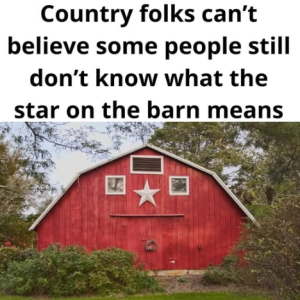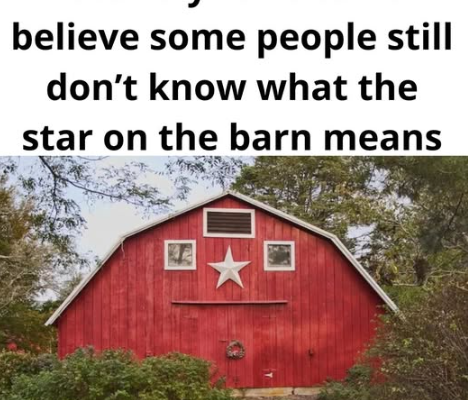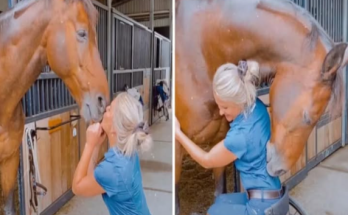
The Story Behind “Barn Stars” — Symbols of Pride, Protection, and Rural Heritage
Across the backroads of America, especially in Pennsylvania, Ohio, and the rolling farmlands of the Midwest, a curious sight greets travelers: colorful, symmetrical stars painted or mounted on the sides of barns. Some are bright red or cobalt blue; others are simple metallic designs that gleam in the sunlight. To the casual passerby, they might seem like decoration—a splash of color against weathered wood. But behind these “barn stars” lies a story rich in history, folklore, and faith—a legacy woven into the fabric of American rural life.
Roots in European Tradition
The tradition of decorating barns with stars traces back to the 18th and 19th centuries, when German and Swiss immigrants—many of whom became known as the “Pennsylvania Dutch”—settled in the American colonies. These farmers brought with them not only their language and agricultural skills but also a deep belief in symbolism and design as expressions of identity and faith.
In Europe, decorative motifs were often painted on homes and barns for both practical and spiritual reasons. Farmers believed that certain shapes, colors, and patterns could bring good fortune, ward off evil, or symbolize divine protection. When these settlers arrived in Pennsylvania and surrounding states, they adapted the practice to their new environment, painting stars and geometric symbols on barns as a continuation of their heritage.
The Early Barn Star
By the mid-1800s, the barn star had become a common sight on Pennsylvania barns. Early examples were simple, often hand-painted five-pointed stars made with natural pigments mixed with milk or linseed oil for durability. The stars were usually painted directly onto the wood siding, sometimes surrounded by circular or floral designs.
These stars weren’t merely aesthetic. For many farmers, they represented the builder’s mark—a symbol of craftsmanship and pride. A barn was one of a farmer’s most valuable possessions, built to last generations, and adding a star at the end of construction was a way of “signing” the work, much like an artist signs a painting.
Over time, these stars came to be associated with prosperity, protection, and good luck. Some families even chose specific colors and styles to reflect personal or spiritual meanings. The barn star became both a family emblem and a community hallmark.
The Rise of Hex Signs
In the same regions where barn stars flourished, another form of folk art emerged: the hex sign. Although the two are often confused, they are distinct traditions. Hex signs—circular, brightly colored patterns painted on wooden disks—became popular among Pennsylvania Dutch communities in the early 20th century. These designs featured hearts, tulips, birds, and other symbols, often accompanied by blessings or charms for fertility, health, and fortune.
Barn stars, by contrast, are simpler and less explicitly magical. They predate the hex sign tradition and tend to use straightforward star shapes rather than complex motifs. Yet both share the same cultural DNA: they are expressions of hope, identity, and connection to the land.
A Star for Every Meaning
The beauty of barn stars lies in their variety. Farmers selected colors and patterns intentionally, each shade carrying its own symbolism:
-
Black represented protection and harmony.
-
Blue stood for peace, calm, and spirituality.
-
Red symbolized emotion, passion, and strength.
-
Green denoted fertility, growth, and abundance.
-
White reflected purity and positive energy.
-
Brown suggested friendship and comfort.
-
Yellow evoked health, love, and the warmth of the sun.
Some stars featured six or eight points, drawing inspiration from Christian iconography, celestial imagery, or even nautical navigation. The five-pointed star—resembling those used in American flags—often symbolized good fortune and the guiding light of faith.
Faith and Folk Belief
Although not all farmers ascribed mystical meanings to their barn stars, many did believe the symbols held protective power. The idea that symbols could ward off misfortune runs deep in European folk belief, and the Pennsylvania Dutch were no exception. For some, a barn star was a charm to guard against lightning strikes, sickness in livestock, or crop failure.
Others viewed the star as a Christian emblem—a reminder of the Star of Bethlehem that guided the wise men. In this interpretation, the star was both decoration and devotion, marking the barn as a place under divine care.
Yet even among those who denied any religious or magical significance, the barn star still carried emotional weight. It represented diligence, pride in hard work, and connection to the rhythms of rural life. It was a silent promise between generations: this land, this labor, this legacy endures.
The 20th Century Revival
By the early 1900s, industrialization and modern architecture began to change the landscape of American farms. Old wooden barns gave way to concrete and steel structures, and many traditional folk practices faded. For a time, barn stars nearly disappeared, remembered only by collectors and historians of Pennsylvania Dutch culture.
But in the mid-20th century, as Americans began to romanticize rural life and folk art, the barn star made a comeback. Companies began mass-producing metal versions of the traditional designs, which could be easily hung on homes, garages, or garden sheds. What had once been a regional custom transformed into a national trend.
By the 1990s and early 2000s, barn stars became a popular home décor item. You could find them in craft stores, antique shops, and suburban porches across the country. Though many buyers were unaware of their origins, the star’s rustic charm and timeless shape resonated deeply. It symbolized comfort, simplicity, and a longing for authenticity in an increasingly digital world.
Modern Meaning
Today, the barn star continues to evolve. On working farms, it remains a cherished symbol of heritage. In urban homes, it’s a design element that connects people to a slower, more grounded way of life. Some see it as a nod to Americana; others treat it as a personal good-luck charm or family emblem.
Interestingly, the star’s meaning has expanded beyond its Pennsylvania Dutch roots. It now represents unity, resilience, and the enduring power of craftsmanship. In times of uncertainty, its symmetry and brightness seem to remind us of something eternal—hope shining through hardship.
Preserving the Legacy
In recent years, heritage organizations and folk artists have worked to preserve the history of barn stars and educate the public about their origins. Artisans continue to hand-paint stars using traditional methods, keeping alive the connection between old-world symbolism and modern craftsmanship.
Driving through rural Pennsylvania today, one can still see barns proudly displaying stars weathered by decades of wind and sun. They serve as silent storytellers, linking past to present, reminding all who pass that beauty and meaning can live in the simplest of forms.
A Star That Endures
The story of the barn star is ultimately the story of perseverance—of immigrants carrying their traditions to new soil, of families expressing faith through art, and of communities finding identity in shared symbols. Whether seen as decoration, protection, or heritage, the barn star remains a powerful emblem of American rural life.
Its five-pointed arms stretch across centuries, connecting generations through color, craftsmanship, and quiet pride. Each star tells a story—not just of the farmer who painted it, but of the enduring human desire to find meaning, beauty, and light in the work of our own hands.

